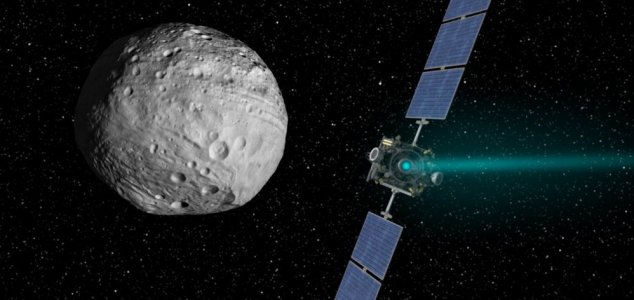Space & Astronomy
January 26, 2015 · 14 comments
14 comments

Dawn spent two years investigating Vesta. Image Credit: NASA / JPL
Conventional thinking would seem to rule out the possibility that water could flow on the surface of such an object, but now scientists looking over photographs and data recorded during the mission have identified physical signs of short-lived flows of water-mobilized material within some of its craters.
"Nobody expected to find evidence of water on Vesta," said study co-author Jennifer Scully. "The surface is very cold and there is no atmosphere, so any water on the surface evaporates."
While the find doesn't indicate that Vesta was home to whole rivers of flowing water, the discovery does suggest that enough water was present to cause the sand and dust to move.
The find could have huge implications in the field of planetary science and means that some of the processes thought to occur only on planets can in fact take place on asteroids as well.
The team behind the Dawn mission are now keen to discover whether traces of these same processes will be found on Ceres when the probe arrives there in March.
Source: Red Orbit | Comments (14)
Evidence of flowing water found on Vesta
By T.K. RandallJanuary 26, 2015 ·
 14 comments
14 comments
Dawn spent two years investigating Vesta. Image Credit: NASA / JPL
Scientists have discovered indications that liquid water was once present on the asteroid's surface.
Visited by NASA's Dawn spacecraft back in 2011, Vesta is the second largest known asteroid in the solar system.Conventional thinking would seem to rule out the possibility that water could flow on the surface of such an object, but now scientists looking over photographs and data recorded during the mission have identified physical signs of short-lived flows of water-mobilized material within some of its craters.
"Nobody expected to find evidence of water on Vesta," said study co-author Jennifer Scully. "The surface is very cold and there is no atmosphere, so any water on the surface evaporates."
The find could have huge implications in the field of planetary science and means that some of the processes thought to occur only on planets can in fact take place on asteroids as well.
The team behind the Dawn mission are now keen to discover whether traces of these same processes will be found on Ceres when the probe arrives there in March.
Source: Red Orbit | Comments (14)

The Unexplained Mysteries
Book of Weird News
AVAILABLE NOW
Take a walk on the weird side with this compilation of some of the weirdest stories ever to grace the pages of a newspaper.
Click here to learn more

Support us on Patreon
BONUS CONTENTFor less than the cost of a cup of coffee, you can gain access to a wide range of exclusive perks including our popular 'Lost Ghost Stories' series.
Click here to learn more
United States and the Americas
Extraterrestrial Life and The UFO Phenomenon
Ancient Mysteries and Alternative History
Ghosts, Hauntings and The Paranormal
Total Posts: 7,751,888 Topics: 324,035 Members: 203,512
Not a member yet ? Click here to join - registration is free and only takes a moment!
Not a member yet ? Click here to join - registration is free and only takes a moment!





























Please Login or Register to post a comment.